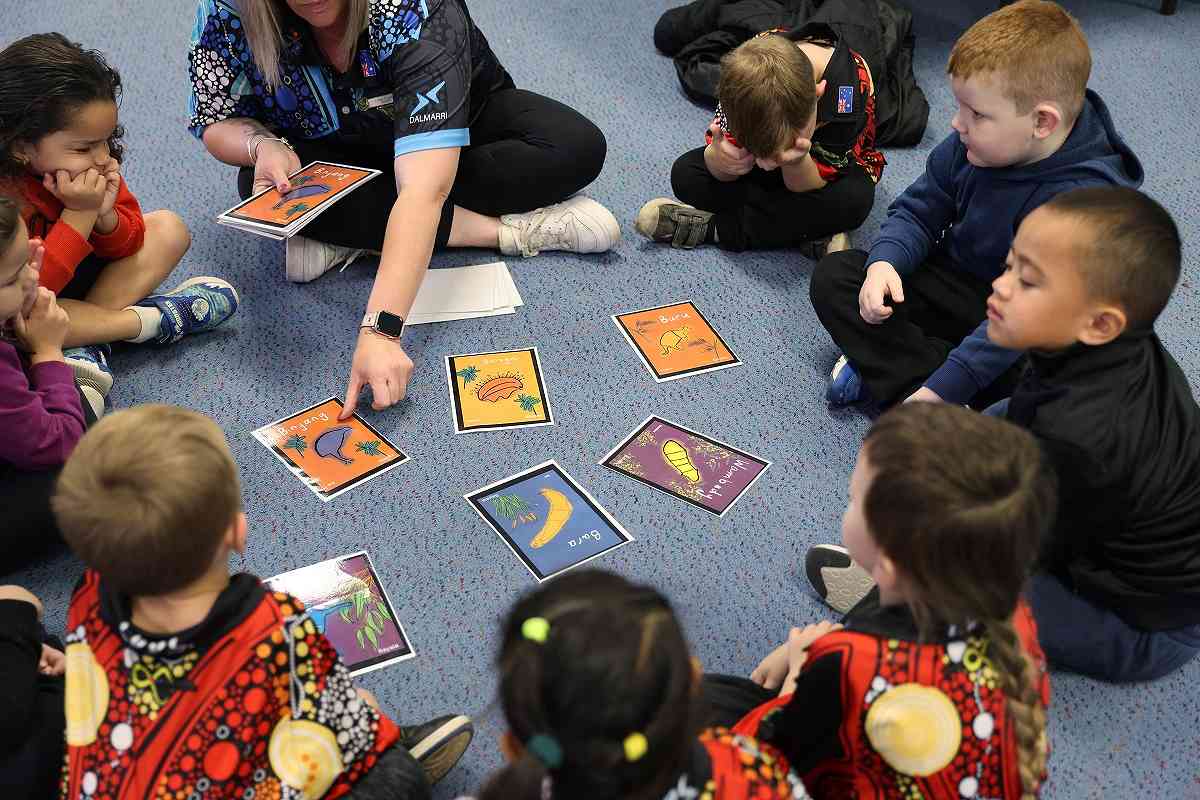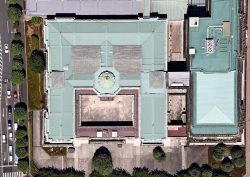
Children study the Dharug language at Lethbridge Park Public School in Sydney on May 8.
16:03 JST, September 18, 2023
COFFS HARBOUR, Australia (Reuters) — Whirling barefoot in a sand circle, Clark Webb leads a class of school children as they dance to clapsticks and the songs of the Gumbaynggirr, an Aboriginal Australian people.
“Opening our own schools, that’s sovereignty in action,” said Webb, one of those seeking to revive the Indigenous language spoken in Coffs Harbour, a coastal town about 500 kilometers north of Sydney.
“And so we need that ‘Voice’ there to lobby for that.”
Webb was referring to a procedure called the “Voice to Parliament,” which will go to a referendum on Oct. 14 to decide whether Indigenous People get recognition in Australia’s constitution for the first time.
When it opened last year, the Gumbaynggirr Giingana Freedom School (GGFS) that Webb helped found was the first bilingual Indigenous one in Australia’s most populous state of New South Wales.
It is part of a bottom-up attempt to revive dozens of languages that verged on extinction, and is also being supported by federal and state governments.
Many of Australia’s Indigenous people see the revival of language as critical to ensuring the survival of their cultures, in one of the most important years for Indigenous rights in the country’s history.
Language preservation is one of the key planks of the “Yes” campaign going into the referendum.
Oldest culture
Australia’s Indigenous, or Aboriginal and Torres Strait Islander communities, are arguably the world’s oldest, with a history on the continent stretching back tens of thousands of years.
But after colonization by Great Britain in 1788, they increasingly faced discrimination, which continued long after Australia became a nation in 1901.
Authorities often relocated Indigenous people from their traditional lands, known as Country, and forcibly separated Indigenous children from their families, resulting in a “stolen generation” because of policies that ran from the mid-19th century to the 1970s.
As late as the 1980s, authorities punished Indigenous people for speaking their languages.
“I think, growing up, I knew there was something missing from my life,” Webb said. “And as I got older, I realized that the missing link for me was our language.”
Webb estimates there are now about 30 proficient or highly proficient speakers of Gumbaynggirr, among them his 9-year-old daughter Jayalaani.
“It feels good, because at my old school I never used to go out on Country,” she said.
“Maybe once a year we went somewhere. But now at this school, we can do it every Thursday. It feels connecting to Country.”
Revival beginnings
Australia has one of the world’s highest rates of language loss in the world.
At the time of European colonization, more than 250 Indigenous languages, including 800 dialects, were believed to have been spoken continent-wide, the Australian Institute of Aboriginal and Torres Strait Islander Studies (AIATSIS) says.
But the most recent census showed that despite more than 150 languages still being spoken in 2021, just 9.5% of Indigenous Australians reported speaking one or more at home.
Ray Ingrey is one of a handful of people fluent in Dharawal, the first language heard by British explorer Captain James Cook when he landed in Australia in 1770.
He chairs the Gujaga Foundation, founded in 2019 to revive the language, partly by using recordings made by anthropologists of Dharawal elders in the 1960s.
“When you’ve learned Dharawal, you’ll also learn a lot of the hardship our people went through to continue having their language,” Ingrey said.
The arbitrary government policies of those days dismantled the transmission of language from one generation to the next, he added.
Authorities had forbidden the grandparents of Webb and Ingrey from speaking their native languages, and some relatives were threatened by the police for speaking it anywhere.
Author and teacher Jasmine Seymour is leading efforts to revive the Dharug language among hundreds of state school children in Sydney, the majority of them non-Indigenous.
A descendant of Maria Lock, the first Aboriginal person to marry a European settler and one of the first admitted to a school to learn English, Seymour was observing a lesson at Lethbridge Park Public School in Sydney’s west.
“To be at the other end of history, where my language is being revitalized in school, is completely profound,” she said.
“And I never take it for granted. It really is an amazing thing.”
"World" POPULAR ARTICLE
-

8 Japanese Nationals Stranded on Indonesia’s Sumatra Island
-

Mozambican Cooking Class Held in Matsuyama, Ehime Pref.; Participants Don Aprons, Bandanas Made from Traditional Mozambique Fabric
-

China to Impose Sanctions on Shigeru Iwasaki, Former Head of Japan’s Self-Defense Forces, Who Serves as Adviser to Taiwan’s Executive Branch
-

China Steps Up ‘Wolf Warrior’ Diplomacy Against Japan, Hurling Accusation About Plutonium Stockpile
-

South Korea’s Top Court Dismisses Nippon Steel Appeal in Lawsuit over Requisitioned Worker
JN ACCESS RANKING
-

Keidanren Chairman Yoshinobu Tsutsui Visits Kashiwazaki-Kariwa Nuclear Power Plant; Inspects New Emergency Safety System
-

Imports of Rare Earths from China Facing Delays, May Be Caused by Deterioration of Japan-China Relations
-

Japan Pulls out of Vietnam Nuclear Project, Complicating Hanoi’s Power Plans
-

Govt Aims to Expand NISA Program Lineup, Abolish Age Restriction
-

Blanket Eel Trade Restrictions Rejected


























